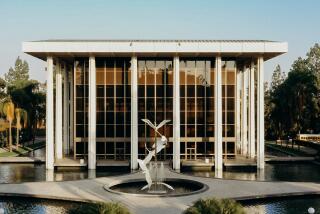MUSIC REVIEW : Soviet Pianist Petrov in West Coast Debut at Ambassador Auditorium
- Share via
After several visits to the Eastern seaboard, Nikolai Petrov, finally reached the West Coast Monday night, courtesy of the Ambassador International Cultural Foundation.
The 44-year-old Soviet pianist brought a heavy-duty display program for this debut recital in Ambassador Auditorium. In it, he exhibited feats of strength, stamina, speed and flexibility, plus an immense, round, fat tone, as outsize in its carrying power as his abundant technical resources.
Petrov, who in 1962 at age 19, took second prize (behind Ralph Votapek) at the Van Cliburn International Competition, is no pounder and no keyboard clod. He may excel in projecting the longer, arching line and in creating an integral whole out of many compositional fragments, yet he does not slight the smaller artistic gesture or skim over complicated paths of musical thought.
But he does seem to specialize in the grandiose.
His introductory program stressed the “symphonic” aspects of piano-playing--that is, the complexities and architectonic elements in three orchestrally conceived works: Schumann’s “Symphonic” Etudes, Opus 13; Saint-Saens’ Second Piano Concerto, in the transcription for piano solo by Georges Bizet, and Ravel’s own arrangement of his “La Valse.”
As far as it went, this challenging agenda showed Petrov’s unflinching command of keyboard technicalities. And he maneuvered easily through it, cutting a path like a field-harvester with a scythe--through thickets of octaves, hedgerows of chordal passages, and a dense undergrowth of 32nd-notes.
Beyond that--and beyond the admirable gentility of his very large, mellow and fluid tone--Petrov does not offer much refreshment for the spirit or grist for the intellect.
He caressed the inner workings of Schumann’s quieter (but never easy) Etudes without bringing much personality or poignancy to them. He leaped all the hurdles in Saint-Saens’ showy G-minor Concerto without making its poetry particularly convincing. And he never let us forget that, for all its glitter, “La Valse” on the piano is eternally monochromatic.
As a technician of wide and abundant resources, Petrov is a wondrous, certainly not unmusical, piano-playing machine. But the machine is not charming. Time and again in this very pleasant evening, a lack of personal statement and an absence of a clear, emotive connection between stage and audience were felt.
Nevertheless, a hard-listening and friendly audience (more than 800 in the 1,250-seat hall) applauded lustily--some even stood, at crucial points in the recital--for this splendid display.
At the end, Petrov’s two encores fell neatly into place. They were both by Saint-Saens: Leopold Godowsky’s transcription of “Le Cygne,” and the “Etude en forme de Valse,” in D-flat.
More to Read
The biggest entertainment stories
Get our big stories about Hollywood, film, television, music, arts, culture and more right in your inbox as soon as they publish.
You may occasionally receive promotional content from the Los Angeles Times.










